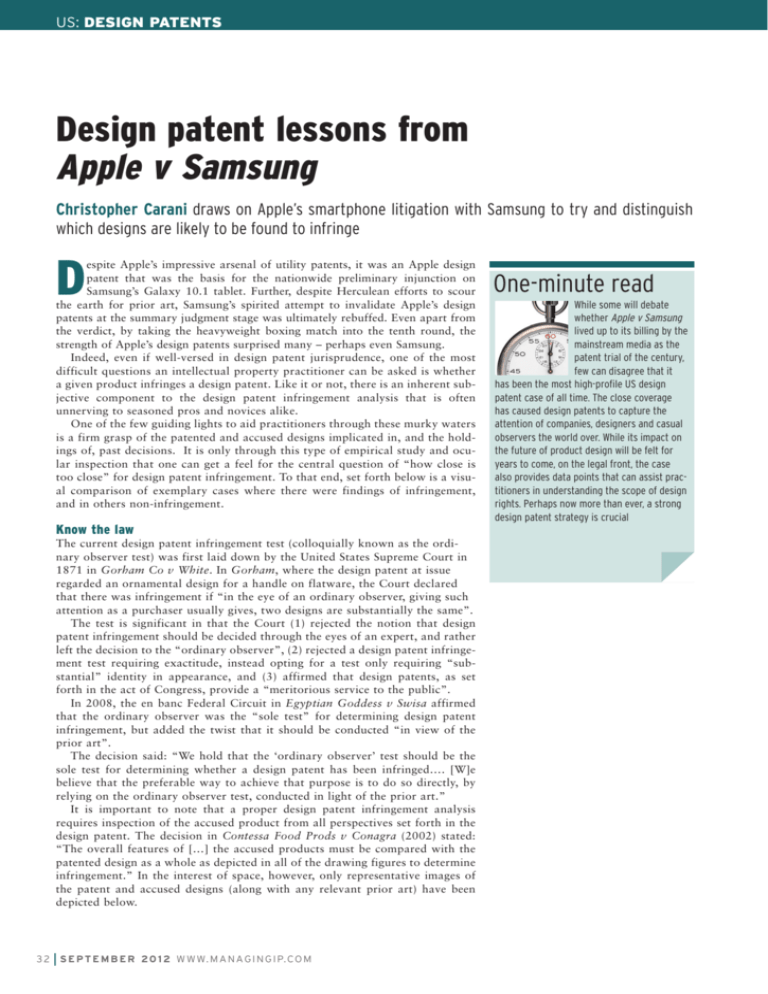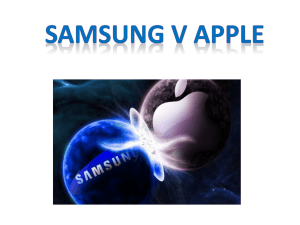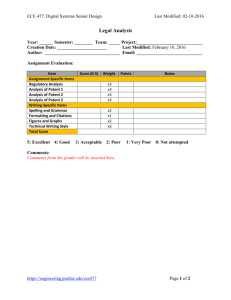Apple v Samsung - Patently-O
advertisement

US: DESIGN PATENTS Design patent lessons from Apple v Samsung Christopher Carani draws on Apple’s smartphone litigation with Samsung to try and distinguish which designs are likely to be found to infringe D espite Apple’s impressive arsenal of utility patents, it was an Apple design patent that was the basis for the nationwide preliminary injunction on Samsung’s Galaxy 10.1 tablet. Further, despite Herculean efforts to scour the earth for prior art, Samsung’s spirited attempt to invalidate Apple’s design patents at the summary judgment stage was ultimately rebuffed. Even apart from the verdict, by taking the heavyweight boxing match into the tenth round, the strength of Apple’s design patents surprised many – perhaps even Samsung. Indeed, even if well-versed in design patent jurisprudence, one of the most difficult questions an intellectual property practitioner can be asked is whether a given product infringes a design patent. Like it or not, there is an inherent subjective component to the design patent infringement analysis that is often unnerving to seasoned pros and novices alike. One of the few guiding lights to aid practitioners through these murky waters is a firm grasp of the patented and accused designs implicated in, and the holdings of, past decisions. It is only through this type of empirical study and ocular inspection that one can get a feel for the central question of “how close is too close” for design patent infringement. To that end, set forth below is a visual comparison of exemplary cases where there were findings of infringement, and in others non-infringement. Know the law The current design patent infringement test (colloquially known as the ordinary observer test) was first laid down by the United States Supreme Court in 1871 in Gorham Co v White. In Gorham, where the design patent at issue regarded an ornamental design for a handle on flatware, the Court declared that there was infringement if “in the eye of an ordinary observer, giving such attention as a purchaser usually gives, two designs are substantially the same”. The test is significant in that the Court (1) rejected the notion that design patent infringement should be decided through the eyes of an expert, and rather left the decision to the “ordinary observer”, (2) rejected a design patent infringement test requiring exactitude, instead opting for a test only requiring “substantial” identity in appearance, and (3) affirmed that design patents, as set forth in the act of Congress, provide a “meritorious service to the public”. In 2008, the en banc Federal Circuit in Egyptian Goddess v Swisa affirmed that the ordinary observer was the “sole test” for determining design patent infringement, but added the twist that it should be conducted “in view of the prior art”. The decision said: “We hold that the ‘ordinary observer’ test should be the sole test for determining whether a design patent has been infringed…. [W]e believe that the preferable way to achieve that purpose is to do so directly, by relying on the ordinary observer test, conducted in light of the prior art.” It is important to note that a proper design patent infringement analysis requires inspection of the accused product from all perspectives set forth in the design patent. The decision in Contessa Food Prods v Conagra (2002) stated: “The overall features of […] the accused products must be compared with the patented design as a whole as depicted in all of the drawing figures to determine infringement.” In the interest of space, however, only representative images of the patent and accused designs (along with any relevant prior art) have been depicted below. 3 2 S E P T E M B E R 2 0 1 2 W W W. M A N A G I N G I P. C O M One-minute read While some will debate whether Apple v Samsung lived up to its billing by the mainstream media as the patent trial of the century, few can disagree that it has been the most high-profile US design patent case of all time. The close coverage has caused design patents to capture the attention of companies, designers and casual observers the world over. While its impact on the future of product design will be felt for years to come, on the legal front, the case also provides data points that can assist practitioners in understanding the scope of design rights. Perhaps now more than ever, a strong design patent strategy is crucial US: DESIGN PATENTS Case studies: infringement Gorham v White Applying the “ordinary observer test”, the Supreme Court in Gorham in 1871 ultimately concluded that White’s accused flatware infringed Gorham’s design patent. Below are representative images for the patented design on the left, and the accused/infringing design on the right. (The published Gorham opinion does not include any images or discussion of the prior art.) US patent Infringing flatware handle design an ordinary observer, familiar with the prior art designs, would be deceived into believing the accused products are the same as the patented design”. Accordingly, a judgment of infringement was entered. Victor Stanley v Creative Pipe Another example of a design patent case where there was a finding of design patent infringement is Victor Stanley v Creative Pipe (District of Maryland, 2011). After a bench trial, the court determined that, despite visually similar prior art, an ordinary observer would conclude that one of the two accused products (a bench end) had an overall visual appearance that was substantially the same as the patented bench end. Prior art US patent Infringing bench end design As can be seen from the visual comparison, there were noticeable differences between (1) the handle silhouettes, and (2) the engraving, including the ribbing, curls and points. Nevertheless, and despite these differences, the Court found that the accused White products incorporated a design that was “substantially the same” as the patented design. Thus, from the outset, the Court has made clear that the design patent infringement test is not a minute analysis of detail but rather a test that asks whether the overall appearance of the patent and accused designs are substantially same in the eyes of an ordinary observer. Specifically, the Court said: “The purpose of the law must be effected if possible; but, plainly, it cannot be if, while the general appearance of the design is preserved, minor differences of detail in the manner in which the appearance is produced, observable by experts, but not noticed by ordinary observers, by those who buy and use, are sufficient to relieve an imitating design from condemnation as an infringement.” While the examples above show that a finding of design patent infringement does not require exactitude, the examples below shows that the test has its limits and requires at minimum “substantial similarity”. Crocs v ITC Richardson v Stanley Works The 2010 Federal Circuit case Crocs v ITC is another reminder that “minor differences between a patented design and an accused article’s design cannot, and shall not, prevent a finding of infringement”. The Crocs court, employing the Gorham test, examined whether Crocs’ US design patent D517,789 (which was directed at aqua clogs) was infringed. A visual analysis of the patented and infringing designs is informative on the issue of “how close is too close”. In Richardson (Federal Circuit, 2010), despite the accused products’ amalgamation of the same three tools (hammer, jaw and crowbar) in the same general configuration, there was a finding of non-infringement because the overall appearances of the patented and accused designs were not substantially the same. A visual analysis of the closest prior art, the patented design and the accused product is shown below. US patent Infringing shoe design Here again, despite noticeable differences in detail (for example, hole shape, holes arrangement and toe shape), the Federal Circuit concluded that “side-by-side comparisons of the '789 patent design and the accused products suggest that Specifically, the court concluded that while “[t]here are minor differences between the [accused] Nebelli bench end frame and that shown in the Patent…the Nebelli design so nearly resembles that of the patent that an ordinary observer, familiar with prior art designs, would be unable to easily distinguish them in a side-by-side comparison without unusually careful effort”. Case studies: no infringement Prior Art US patent Non-infringing design Similar to the idea-expression dichotomy in copyright law, it is important to note that design patents do not protect general concepts. Instead, they protect the particular design as claimed in the patent drawings. The Richardson design patent did not protect the general functional concept of combining a hammer, W W W. M A N A G I N G I P. C O M S E P T E M B E R 2 0 1 2 3 3 US: DESIGN PATENTS jaw and crowbar into a single tool. Rather, the Richardson design patent protected the particular appearance of this combination of features as shown in the patent drawings. It was this appearance that was properly compared to the accused product, not a verbal recitation of the design’s functional attributes. same as the patented design.” To stay true to the edict of Egyptian Goddess, before giving advice on the issues of infringement, practitioners should always collect the prior art on the face of the design patent (at minimum), and use this art as a frame of reference when conducting the ordinary observer analysis. Egyptian Goddess v Swisa Victor Stanley v Creative Pipe The Federal Circuit’s 2008 en banc decision in Egyptian Goddess is instructive on the limits that prior art can place on the scope of design patents. In Egyptian Goddess, the court abrogated the nettlesome “point of novelty” test, and in its place laid down a rule requiring that the ordinary observer test be conducted, not in a vacuum, but rather in view of the prior art. A visual analysis of the closest prior art, the patented design and the accused product is set forth below. Victor Stanley (District of Maryland, 2011) presents the informative scenario where one product was found to infringe the asserted design patent (as discussed above) and a second accused product was found not to infringe. It is cases like this that help define the line between infringement and non-infringement. A visual analysis of the closest prior art, the patented design and the second accused product is shown below. Here, the court felt that the prior art was quite close in appearance to the patented design and thus the difference between the patented and accused designs were accentuated. Ultimately the court concluded: “In light of the similarity of the prior art buffers to the accused buffer, we conclude that no reasonable fact-finder could find that EGI met its burden of showing, by a preponderance of the evidence, that an ordinary observer, taking into account the prior art, would believe the accused design to be the Specifically, the court stated: “The overall effect of the design with the oval below the seat, while certainly taking advantage of the graceful curves designed into the patented design, creates a different and distinctive look that would not confuse the ordinary observer. Each of the individual ornamental elements may be almost identical in isolation, but the overall impression is aesthetically different.” By avoiding infringement with the addition of an element (the oval), this case raises interesting questions as Prior art US patent Non-infringing design Prior art US patent Non-infringing design WORLDWIDE FOCUSED COMPREHENSIVE The Global IP Resource Cases analysed | Laws reviewed | Trends reported | Key figures interviewed Markets surveyed | Statistics probed START YOUR FREE TRIAL Call: +44 (0) 20 7779 8788 | Email: j_davies@euromoneyplc.com | www.managingip.com/freetrial 3 4 S E P T E M B E R 2 0 1 2 W W W. M A N A G I N G I P. C O M US: DESIGN PATENTS to whether design patent claims are open or closed claims, conjuring up the distinct difference between the claiming language “consisting of” or “comprising of” in utility patents. It will be interesting to see how this issue is resolved by the Federal Circuit, if ever raised on appeal. There are certainly district court cases that have gone the other way on this issue. As seen from each of the comparisons, there are certainly similarities and differences. The decision of design patent infringement is a quintessential fact question. Thus, factfinders are asked to employ their everyday sensibilities and perceptions to determine whether an accused design crossed the line and infringed. It is important to remember that the “ordinary observer test” is pegged to the evolving percep- Apple v Samsung – a visual study Even after the dust from the epic Apple v Samsung battle has settled, the design patent infringement comparisons from Apple v Samsung will continue to serve as meaningful data points that practitioners can reference when assessing and advising on the issue of design patent infringement. To facilitate this process, below are representative images of the relevant prior art, the asserted Apple design patents (tablets and smart phones), and the accused Samsung products. Prior art Apple patents Samsung Galaxy 10.1 Tab Samsung Galaxy S 4G Samsung Infuse 4G Samsung Galaxy S 4G Samsung Infuse 4G In Apple v Samsung, design patents took centre stage. They will be coming back for an encore tions and sensibilities that develop over time and is subject to the realities of the marketplace. Apple argued vigorously that the overall visual impression of the accused Samsung tablet and smartphone designs were substantially similar to its patented designs. Conversely, and strategically, Samsung focused on differences in detail. Indeed, Samsung challenged Apple’s witnesses by pointing out differences in the precise radius of curvature for each corner of the devices when compared to Apple’s patented design. While it is fair game to argue the differences in constituent elements, the final analysis calls for a more holistic approach, taking into consideration each view from the asserted patents with the corresponding view from the accused product. In Apple v Samsung, design patents took centre stage and grabbed the headlines. They assuredly will be coming back for an encore. As practitioners increasingly are called upon to render advice on design patent infringement, the visual facts of past cases, including Apple v Samsung, should serve as helpful gauges for assessing the difficult question of “how close is too close” when it comes to design patent infringement. © Christopher Carani 2012. Carani is a shareholder at McAndrews Held & Malloy in Chicago On managingip.com Four reasons Samsung's tablet design defence will likely fail, August 2012 Apple v Samsung: the nine people who will decide, August 2012 Florian Müller on life at the smartphone frontline, July 2012 Apple and Samsung face off in London hearing, October 2011 W W W. M A N A G I N G I P. C O M S E P T E M B E R 2 0 1 2 3 5






